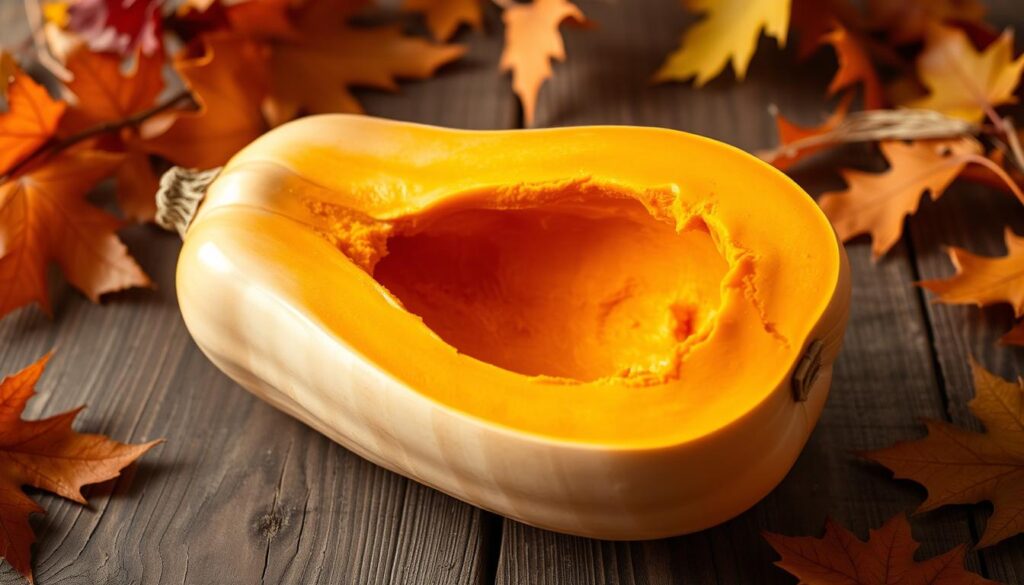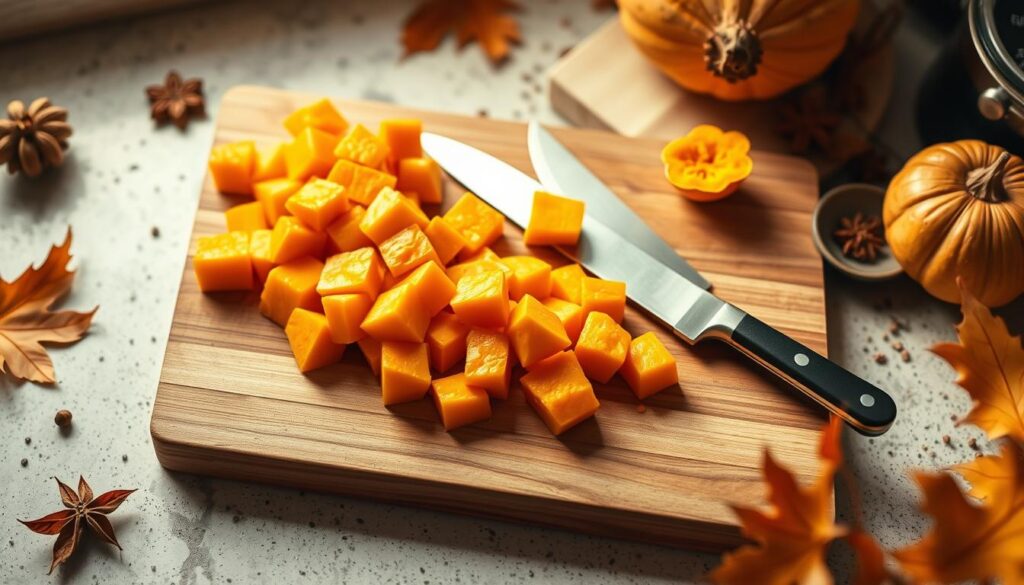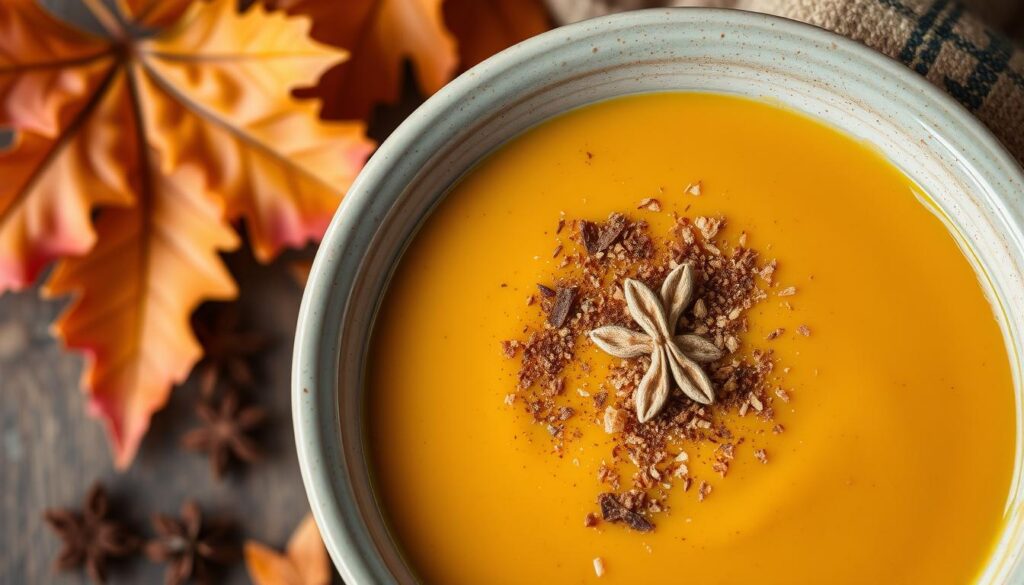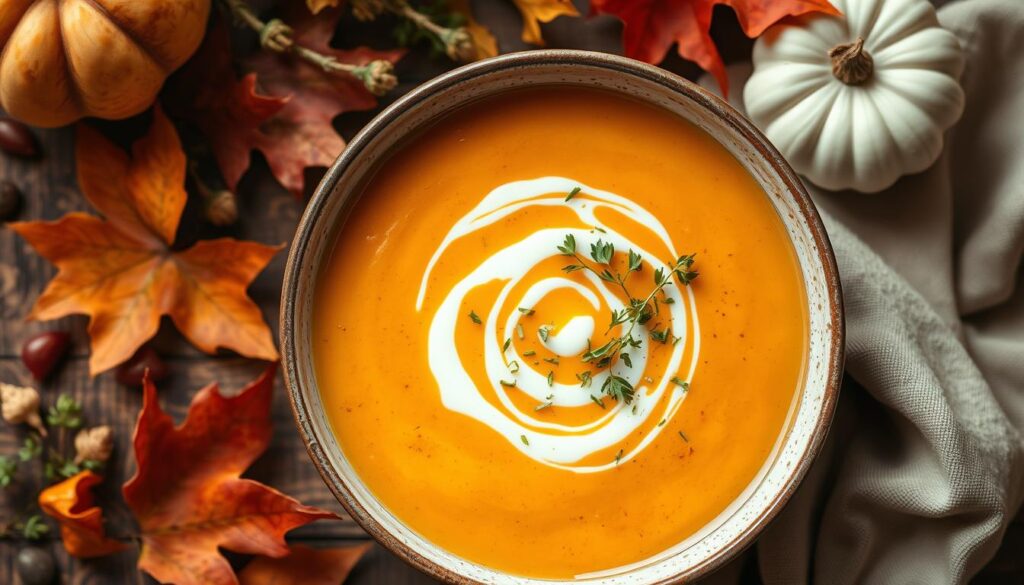As autumn arrives, a warm bowl of homemade butternut squash soup is perfect. It has a rich, velvety texture and a mix of flavors that capture fall’s essence. This easy recipe is great for a nourishing meal or a cozy treat on a cold day.
Key Takeaways
- Butternut squash soup is a quintessential fall comfort food with its creamy texture and warm, autumnal flavors.
- Butternut squash is packed with essential nutrients, making this soup a healthy and satisfying option.
- The recipe is simple to follow and can be customized with various herbs, spices, and garnishes to suit your taste preferences.
- Butternut squash soup is a versatile dish that can be enjoyed as a main course, appetizer, or side, and pairs well with a variety of accompaniments.
- This soup can be made in advance and stored for later, making it a convenient and time-saving option for busy weeknights or holiday gatherings.
Why Butternut Squash Soup Is the Perfect Fall Comfort Food
When the air gets crisp and leaves change colors, nothing beats a warm butternut squash soup. It’s full of health benefits and is a top pick for fall.
Nutritional Benefits of Butternut Squash
Butternut squash is packed with vitamin A, fiber, and antioxidants. It’s rich in beta-carotene, which turns into vitamin A in our bodies. This helps our vision, immune system, and skin.
The fiber in butternut squash also keeps our digestion healthy. It helps our gut stay in top shape.
Seasonal Appeal and Warming Properties
Butternut squash soup is the essence of fall. It uses seasonal ingredients and warms us up on cold days. Its creamy texture and sweet taste are perfect for cozy times.
Looking for a healthy meal or something to share with family? Butternut squash soup is the answer. It’s a mix of great taste, nutrition, and fall charm.
“Autumn is a second spring when every leaf is a flower.” – Albert Camus
Essential Ingredients for Perfect Butternut Squash Soup
Making a delicious butternut squash soup starts with picking the best ingredients. At its core, this soup needs a few key parts. These parts mix together to create a perfect blend of tastes and textures.
The main ingredient is fresh butternut squash. Choosing a ripe, vibrant squash is crucial. It gives the soup a rich, sweet flavor that you’ll love with every spoonful.
For a creamy and flavorful soup, you need a good vegetable broth. This broth helps the squash’s flavors shine. It makes the squash’s delicate taste come alive.
- Adding heavy cream or coconut milk makes the soup creamy and indulgent.
- Spices like cinnamon, nutmeg, and ginger add warm, comforting flavors.
- Fresh aromatics like onions, garlic, and thyme create a flavorful base.
With these key ingredients, you’re ready to make a butternut squash soup. It will be not only healthy but also a treat for your taste buds.
“The key to an exceptional butternut squash soup lies in the quality and balance of its ingredients.”

Kitchen Equipment You'll Need
Making a tasty butternut squash soup needs the right tools and appliances. You can make a basic recipe with just a few items. But, the right equipment makes cooking easier and the soup better.
Must-Have Tools and Appliances
- A large stockpot or Dutch oven to hold all the soup ingredients
- A sharp knife and cutting board for cutting the butternut squash
- An immersion blender or regular blender to make the soup smooth
- A wooden spoon or heat-resistant spatula for stirring and scraping the pot
Optional Equipment for Enhanced Results
While you can make a great butternut squash soup with the basics, some extra tools can make it even better:
- A food processor for chopping the squash and veggies quickly and evenly
- A roasting pan for roasting the squash to bring out its sweetness
- A potato masher or ricer for an extra creamy soup
- A hand-held milk frother for a luxurious foam on top
With the right tools and appliances, you’re ready to make a comforting butternut squash soup. It will impress your family and friends.
Preparing and Cutting Your Butternut Squash
Butternut squash is a versatile and delicious ingredient, but preparing it can seem daunting at first. Fear not! With a few simple steps, you’ll be peeling butternut squash, cubing squash, and roasting squash like a pro.
First, start by washing the butternut squash under running water. Using a sturdy knife, carefully slice off the stem and bottom ends of the squash. This will give you a stable base to work with.
- Using a vegetable peeler, peel the skin off the squash, taking care to remove all the tough outer layer.
- Once peeled, place the squash on a cutting board and cut it in half lengthwise. Use a spoon to scoop out the seeds and stringy pulp from the center.
- Lay the squash halves flat on the cutting board and slice them into 1-inch thick half-moon pieces.
- Finally, cut the half-moon slices into 1-inch cubes, creating the perfect size for your butternut squash soup.
With your peeled, cubed, and roasted squash ready, you’re now one step closer to creating a delectable batch of creamy butternut squash soup. Remember to handle the squash with care, as the skin can be tough and the flesh can be slippery.

“Butternut squash is a true autumn treasure, bringing warmth and coziness to any dish.”
Butternut Squash Soup Recipe
Get ready to enjoy the warm taste of homemade butternut squash soup. It’s perfect for cozy fall days, blending sweetness with creaminess. You can make this delicious soup with just a few ingredients and simple steps in your kitchen.
Base Ingredients List
- 1 large butternut squash, peeled, seeded, and cubed
- 1 onion, diced
- 3 cloves of garlic, minced
- 4 cups of vegetable or chicken broth
- 1 cup of heavy cream
- 2 tablespoons of unsalted butter
- Salt and black pepper to taste
Step-by-Step Instructions
- Preheat your oven to 400°F (200°C).
- Spread the cubed butternut squash on a baking sheet, drizzle with olive oil, and roast for 25-30 minutes, or until the squash is tender and caramelized.
- In a large pot, melt the butter over medium heat. Add the diced onion and sauté for 5-7 minutes until translucent.
- Add the minced garlic and sauté for an additional minute, being careful not to burn the garlic.
- Pour in the vegetable or chicken broth and the roasted butternut squash. Bring the mixture to a boil, then reduce the heat and let it simmer for 15-20 minutes.
- Using an immersion blender or regular blender, puree the soup until it’s smooth and creamy.
- Stir in the heavy cream and season with salt and black pepper to taste.
- Reheat the soup if necessary and serve hot, garnished with your favorite toppings.
Cooking Times and Temperatures
Roast the butternut squash at 400°F (200°C) for 25-30 minutes. Simmer the soup for 15-20 minutes after adding the broth and roasted squash.
Tips for Achieving the Perfect Creamy Texture
Making a silky-smooth butternut squash soup is an art. The right blending techniques are key to getting that creamy texture. Whether you like it velvety or a bit chunky, these tips will help you get it right every time.
Blending for Creaminess
The secret to a luscious, smooth soup is in the blending. Use a high-powered blender or immersion blender to purée the cooked squash and other ingredients. Make sure there are no lumps or grainy bits. Blend until it’s silky-smooth and velvety.
Straining for Ultra-Creaminess
For an even creamier texture, try straining the soup. Use a fine mesh sieve or cheesecloth. This step removes tiny bits or fibers, making the soup exceptionally smooth and luxurious.
| Blending Technique | Texture Result |
|---|---|
| High-powered blender or immersion blender | Velvety, silky-smooth puree |
| Blending + Straining | Ultra-creamy, refined texture |
With these simple blending techniques and an optional straining step, you’ll make the perfect smooth soup. Your homemade butternut squash soup will have a silky-smooth texture that impresses everyone.

Flavor Variations and Seasonal Spices
The basic butternut squash soup is a fall favorite. But, you can add unique flavors and spices to make it your own. Try a curry butternut squash soup or a zesty apple butternut squash soup for something different.
Herb and Spice Combinations
Play with spice blends to match the butternut squash’s sweetness. Here are some great mixes:
- Warm spices like cinnamon, nutmeg, and ginger for a cozy, autumnal flavor
- Earthy herbs like thyme, rosemary, and sage to create a savory, aromatic backdrop
- Smoky paprika and cumin for a hint of depth and complexity
- Fragrant curry powder, turmeric, and garam masala for a dynamic, global twist
Creative Add-ins
Be bold with your butternut squash soup. Add ingredients that boost the flavor. Think about:
- Roasted apples or pears for a touch of sweetness
- Toasted nuts or seeds for a delightful crunch
- Coconut milk or cream for a silky, indulgent texture
- Fresh herbs like cilantro, parsley, or chives for a bright, herbal note
Butternut squash soup is all about being versatile. Tailor it to your taste and the season. Have fun trying new flavors to make it your own.

Garnishing and Serving Suggestions
Make your butternut squash soup stand out with creative garnishes and serving ideas. Turn this cozy fall dish into a feast for the eyes and taste buds.
Soup Toppings to Elevate the Dish
- Crispy fried sage leaves
- Toasted pumpkin seeds or crushed candied pecans
- A drizzle of crème fraiche or sour cream
- Freshly grated Parmesan cheese
- Finely chopped chives or scallions
These toppings bring texture, color, and flavor to your soup. Each spoonful becomes a joy to eat.
Creative Presentation Ideas
Use serving bowls that match the autumn colors. Try serving it in mini pumpkins or acorn squashes for a rustic look. Top it with toasted pepitas, fresh thyme, or maple-sweetened whipped cream.
“The way you present your food is just as important as the way it tastes. It’s all about creating a memorable dining experience.”
With the right soup toppings and presentation ideas, your butternut squash soup becomes a feast for the eyes and taste buds.
Storage and Reheating Guidelines
Proper storage and reheating are crucial for your butternut squash soup. They help keep its creamy texture and flavor. Follow these tips to keep your soup delicious for longer.
Storing Leftover Soup
For leftover soup, put it in an airtight container and refrigerate for up to 4 days. You can also freeze it for up to 3 months. Make sure to leave some space in the container for expansion when freezing.
Reheating Your Soup
There are easy ways to reheat your soup without losing its texture:
- On the stovetop: Reheat the soup over medium heat, stirring often, until it’s warm.
- In the microwave: Use a microwave-safe bowl and heat in 30-second intervals, stirring between each, until hot.
- In the oven: Preheat to 350°F (175°C). Put the soup in an oven-safe dish and bake for 15-20 minutes, or until hot.
Choose your method, but always stir well and check the temperature before serving. This ensures it’s hot and ready to enjoy.
“Proper storage and reheating are the keys to keeping your butternut squash soup as delicious as the day it was made.”
By using these freezing soup, leftover storage, and reheating instructions, you can enjoy your butternut squash soup for a long time. Enjoy every spoonful!
Pairing Recommendations for a Complete Meal
To make a complete autumn feast, pair your butternut squash soup with side dishes, breads, and wines. This mix will make your meal tasty, beautiful, and well-coordinated.
Complementary Side Dishes
For a soup and salad combo, serve your butternut squash soup with a crisp mixed green salad. Add roasted beets, candied walnuts, and a tangy balsamic vinaigrette. You can also try a kale and apple salad with a light apple cider vinaigrette.
Bread and Wine Pairings
For a complete meal, offer freshly baked crusty bread like rustic sourdough or whole-grain loaf. These breads will match the soup’s creaminess. For wine, a medium-bodied Chardonnay or dry Riesling will highlight the squash’s sweet and earthy flavors. A light-bodied Pinot Noir is also a great choice.
FAQ
What are the key ingredients in this creamy butternut squash soup recipe?
This butternut squash soup needs fresh butternut squash, vegetable broth, and heavy cream. You’ll also need garlic, onions, and spices like nutmeg, cinnamon, and cayenne pepper.
What are the health benefits of butternut squash?
Butternut squash is full of vitamins A, fiber, and antioxidants. It’s great for your immune system, digestion, and can help reduce inflammation.
What kitchen equipment is needed to make this soup?
You’ll need a large stockpot or Dutch oven, an immersion blender or regular blender, a roasting pan, and a sharp knife for peeling and cubing the squash.
How do I properly prepare and cut the butternut squash?
Peel the squash first, then cut it in half lengthwise and remove the seeds. Cut it into 1-inch cubes for even cooking. Roasting the squash adds deeper flavor.
What are some flavor variations for this butternut squash soup?
Try adding spices like curry powder, ginger, or cinnamon for unique flavors. You can also add roasted apples, crispy bacon, or toasted pumpkin seeds.
How can I achieve the perfect creamy texture for this soup?
Use an immersion blender or regular blender to purée the soup until smooth. Strain it through a fine-mesh sieve for an extra-velvety texture.
How should I store and reheat leftover butternut squash soup?
Store leftover soup in an airtight container in the fridge for up to 4 days. Reheat it in a saucepan over medium heat, stirring often. You can also freeze it for up to 3 months, thawing it before reheating.
What are some tasty side dishes and pairings for this butternut squash soup?
Serve the soup with a fresh green salad, roasted Brussels sprouts, or crusty bread. For a fuller meal, pair it with a grilled cheese sandwich or a crisp, dry white wine.
Share this post: on Twitter on Facebook








